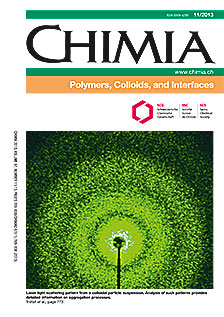Probing Colloidal Particle Aggregation by Light Scattering
DOI:
https://doi.org/10.2533/chimia.2013.772Keywords:
Coagulation, Latex particles, Light scattering, Multivalent ions, Particle aggregation, Simple ionsAbstract
The present article reviews recent progress in the measurement of aggregation rates in colloidal suspensions by light scattering. Time-resolved light scattering offers the possibility to measure absolute aggregation rate constants for homoaggregation as well as heteroaggregation processes. We further discuss the typical concentration dependencies of the aggregation rate constants on additives. Addition of simple salts containing monovalent counterions leads to screening of the electrostatic repulsion of the charged particles and a transition from slow to rapid aggregation. Addition of salts containing multivalent counterions may lead to a charge reversal, which results in a sequence of two instability regions. Heteroaggregation rates between oppositely charged particles decrease with increasing salt level. This decrease is caused by screening of the electrostatic attraction between these particles.Downloads
Published
2013-11-27
Issue
Section
Scientific Articles
License
Copyright (c) 2013 Swiss Chemical Society

This work is licensed under a Creative Commons Attribution-NonCommercial 4.0 International License.
How to Cite
[1]
Chimia 2013, 67, 772, DOI: 10.2533/chimia.2013.772.







